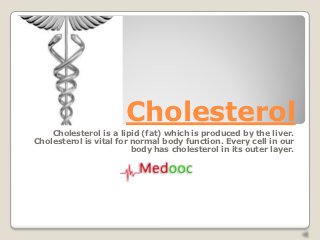
Cholesterol
- 1. Cholesterol Cholesterol is a lipid (fat) which is produced by the liver. Cholesterol is vital for normal body function. Every cell in our body has cholesterol in its outer layer.
- 2. It builds and maintains cell membranes (outer layer), it prevents crystallization of hydrocarbons in the membrane It is essential for determining which molecules can pass into the cell and which cannot (cell membrane permeability) It is involved in the production of sex hormones (androgens and estrogens) It is essential for the production of hormones released by the adrenal glands (cortisol, corticosterone, aldosterone, and others) It aids in the production of bile It converts sunshine to vitamin D. Scientists from the Rockefeller University were surprised to find that taking vitamin D supplements do not seem to reduce the risk of cholesterol-related cardiovascular disease. It is important for the metabolism of fat soluble vitamins, including vitamins A, D, E, and K It insulates nerve fibers What are the functions of cholesterol?
- 3. Cholesterol is carried in the blood by molecules called lipoproteins. A lipoprotein is any complex or compound containing both lipid (fat) and protein. The three main types are: ◦ LDL (low density lipoprotein) - people often refer to it as bad cholesterol. LDL carries cholesterol from the liver to cells. If too much is carried, too much for the cells to use, there can be a harmful buildup of LDL. This lipoprotein can increase the risk of arterial disease if levels rise too high. Most human blood contains approximately 70% LDL - this may vary, depending on the person. ◦ HDL (high density lipoprotein) - people often refer to it as good cholesterol. Experts say HDL prevents arterial disease. HDL does the opposite of LDL - HDL takes the cholesterol away from the cells and back to the liver. In the liver it is either broken down or expelled from the body as waste. ◦ Triglycerides - these are the chemical forms in which most fat exists in the body, as well as in food. They are present in blood plasma. Triglycerides, in association with cholesterol, form the plasma lipids (blood fat). Triglycerides in plasma originate either from fats in our food, or are made in the body from other energy sources, such as carbohydrates. Calories we consume but are not used immediately by our tissues are converted into triglycerides and stored in fat cells. When your body needs energy and there is no food as an energy source, triglycerides will be released from fat cells and used as energy - hormones control this process. There are three main types of lipoproteins
- 4. The amount of cholesterol in human blood can vary from 3.6 mmol/liter to 7.8 mmol/liter. The National Health Service (NHS), UK, says that any reading over 6 mmol/liter is high, and will significantly raise the risk of arterial disease. The UK Department of Health recommends a target cholesterol level of under 5 mmo/liter. Unfortunately, two-thirds of all UK adults have a total cholesterol level of at least five (average men 5.5, average women 5.6). Below is a list of cholesterol levels and how most doctors would categorize them in mg/dl (milligrams/deciliter) and 5mmol/liter (mili moles/liter).Desirable - Less than 200 mg/dL ◦ Bordeline high - 200 to 239 mg/dL ◦ High - 240 mg/dL and above ◦ Optimum level: less than 5mmol/liter ◦ Mildly high cholesterol level: between 5 to 6.4mmol/liter ◦ Moderately high cholesterol level: between 6.5 to 7.8mmol/liter ◦ Very high cholesterol level: above 7.8mmol/liter What are normal cholesterol levels?
- 5. High cholesterol levels can cause: Atherosclerosis - narrowing of the arteries. Higher coronary heart disease risk - an abnormality of the arteries that supply blood and oxygen to the heart. Heart attack - occurs when the supply of blood and oxygen to an area of heart muscle is blocked, usually by a clot in a coronary artery. This causes your heart muscle to die. Angina - chest pain or discomfort that occurs when your heart muscle does not get enough blood. Other cardiovascular conditions - diseases of the heart and blood vessels. Stroke and mini-stroke - occurs when a blood clot blocks an artery or vein, interrupting the flow to an area of the brain. Can also occur when a blood vessel breaks. Brain cells begin to die. If both blood cholesterol and triglyceride levels are high, the risk of developing coronary heart disease rises significantly. Dangers of high cholesterol levels